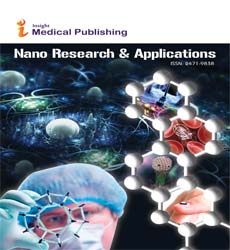Typed and Applications of Nano Sensors
Maysaloun Merhi*
Department of Chemistry and Chemical Engineering, Yangzhou University, Jiangsu, China
- *Corresponding Author:
- Maysaloun Merhi
Department of Chemistry and Chemical Engineering,
Yangzhou University, Jiangsu,
China,
E-mail: maysaloun@gmail.com
Received date: March 27, 2023, Manuscript No. IPNTO-23-16938; Editor assigned date: March 29, 2023, PreQC No. IPNTO-23-16938(PQ); Reviewed date: April 03, 2023, QC No. IPNTO-23-16938; Revised date: April 10, 2023, Manuscript No. IPNTO-23-16938 (R); Published date: April 17, 2023, DOI: 10.36648/2472-9893.9.4.138
Citation: Merhi M (2023) Typed and Applications of Nano Sensors. Nano Res Appl Vol.9 No.4: 138.
Description
Nanosensors have emerged as groundbreaking tools in the field of sensing and detection, enabling highly sensitive and selective monitoring of various physical, chemical, and biological parameters. With their miniaturized size and remarkable properties, nanosensors offer new opportunities for real-time, high-resolution sensing in numerous applications, ranging from healthcare and environmental monitoring to food safety and security. In this article, we explore the world of nanosensors, delving into their principles, fabrication methods, and exciting applications. Nanosensors operate on the principle that when materials are reduced to the nanoscale, their physical and chemical properties can significantly change, leading to enhanced sensitivity and selectivity in detecting target analytes. The fundamental concept underlying nanosensors is the interaction between the analyte and the nanomaterial, which can result in measurable signals such as changes in electrical conductivity, optical properties, mass, or surface plasmon resonance.Various fabrication methods are employed to create nanosensors with tailored properties: Bottom-up approaches: These methods involve the assembly or growth of nanomaterials from atomic or molecular components. Techniques such as chemical vapor deposition, electrochemical deposition, and solgel synthesis enable precise control over the size, shape, and composition of nanosensors. Top-down approaches: Top-down techniques involve the fabrication of nanosensors by downsizing bulk materials using processes like lithography, etching, or milling. These methods offer high precision and reproducibility in creating nanoscale structures. Hybrid approaches: Hybrid methods combine bottom-up and top-down approaches to leverage the advantages of both. For example, nanomaterials can be integrated into lithographically patterned sensor platforms to enhance sensitivity and selectivity.
Types of Nano sensors
Nanosensors can be classified based on the type of nanomaterial employed or the sensing mechanism utilized: Carbon-based nanosensors: Carbon nanotubes, graphene, and carbon dots are extensively studied for their exceptional electrical conductivity and surface properties. These materials can be utilized for sensing a wide range of analytes, including gases, biomolecules, and heavy metals. Metal-based nanosensors: Metallic nanoparticles, such as gold and silver nanoparticles, possess unique optical properties that make them suitable for various sensing applications. Their localized surface plasmon resonance enables ultrasensitive detection of molecules, making them valuable in biomedical sensing and environmental monitoring.Semiconductor nanosensors: Semiconductor nanomaterials like quantum dots and nanowires exhibit size-dependent optical and electronic properties. They offer high sensitivity and selectivity in detecting analytes, making them suitable for applications in biosensing, environmental monitoring, and energy harvesting.
Applications of Nanosensors
Healthcare and Biomedical Sensing: Nanosensors play a critical role in healthcare, enabling early disease detection, personalized medicine, and point-of-care diagnostics. They can detect specific biomarkers, monitor drug delivery, and provide real-time physiological information for disease management. Environmental Monitoring: Nanosensors contribute to environmental monitoring by detecting pollutants, heavy metals, and toxic gases. They aid in ensuring water quality, air pollution control, and industrial safety by offering rapid and sensitive detection capabilities. Food Safety and Agriculture: Nanosensors are employed in food safety applications to detect contaminants, pathogens, and chemical residues. They help ensure the quality and safety of food products throughout the supply chain, enhancing consumer confidence. Security and Defense: Nanosensors are utilized in security and defense applications for detecting explosives, chemical warfare agents, and biothreats. They offer rapid and reliable identification, contributing to enhanced security measures. Industrial Process Monitoring: Nanosensors find application in industrial settings for process monitoring, quality control, and optimization. They enable real-time monitoring of parameters such as temperature, pressure, and gas concentrations, facilitating efficient and safe operations. Challenges and Future Perspectives. Despite the tremendous potential of nanosensors, several challenges remain. Ensuring long-term stability, addressing biocompatibility concerns, and optimizing sensor performance are ongoing areas of research. Additionally, ethical considerations and regulatory frameworks must be established to ensure the safe and responsible deployment of nanosensors. Looking ahead, the future of nanosensors is promising. Continued advancements in nanomaterial synthesis, fabrication techniques, and signal transduction methods will enhance sensor performance and expand their capabilities. Integration with other technologies, such as artificial intelligence and the Internet of Things, will enable smart and autonomous sensing systems with real-time data analysis and decision-making capabilities. Nanosensors represent a revolution in sensing technology, offering unprecedented capabilities in detecting and monitoring a wide range of analytes. Their small size, high sensitivity, and selectivity make them invaluable tools in healthcare, environmental monitoring, food safety, security, and industrial applications. As research and development in nanosensors progress, we can expect continued innovation and broader adoption of these remarkable devices, leading to a safer, healthier, and more sustainable future.
Open Access Journals
- Aquaculture & Veterinary Science
- Chemistry & Chemical Sciences
- Clinical Sciences
- Engineering
- General Science
- Genetics & Molecular Biology
- Health Care & Nursing
- Immunology & Microbiology
- Materials Science
- Mathematics & Physics
- Medical Sciences
- Neurology & Psychiatry
- Oncology & Cancer Science
- Pharmaceutical Sciences
